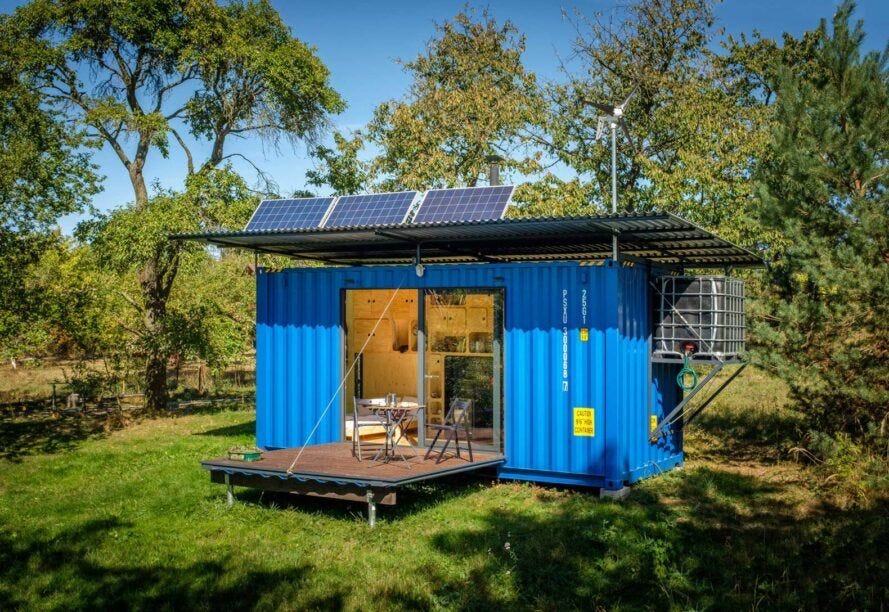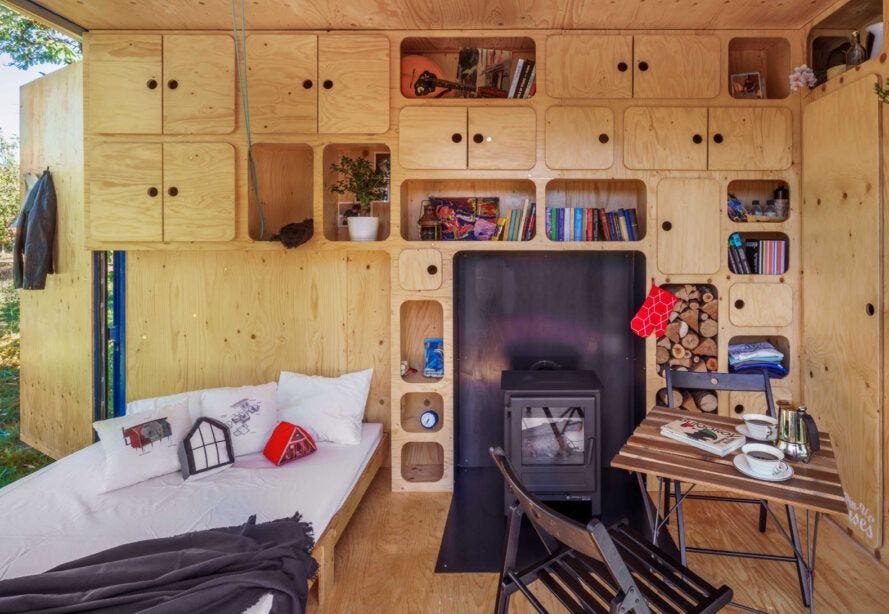The Sunday Read
Are tiny homes a better investment than RVs?; Starlink garners praise; the off-grid lifestyle gets a pan; and more.
The Gaia off-grid container might be a better investment than a recreational vehicle.
By the numbers: RVs versus tiny homes
You plan to go off-grid, but what’s it going to be: van life or a tiny home? That’s the question CNBC.com put to a couple of financial planners when they asked them to evaluate which was better to finance, a RV or a tiny home?
Andrew Westlin, a Betterment financial planner in New York, opined: “Tiny homes are a residence and therefore more easily financed with a mortgage. RVs, on the other hand, are a recreational purchase. Personal loans with lenders like LightStream exist for RVs, but the interest rates probably won’t be as good as you get with a mortgage.”
From Nashville, Tenn., Jeanne Fisher, a financial planner, warned that a “RV, on the other hand, is a depreciating asset. Though the RV market is currently experiencing a boom and prices are higher than normal, this trend won’t last forever.”
The story further cautions readers who purchase tiny homes that they don’t forget to “factor in the cost of land, as well as other unseen costs like digging a well for water and/or providing power to your property (if you plan to go rural or off-grid).”
Starlink continues to garner favourable reviews for its rural high-speed internet
As Elon Musk’s high-speed internet satellite company, Starlink, continues to roll out beta testing, more and more stories about the service and its quality continue to appear.
At Teslarati, which covers all things Musk-related, Simon Alverez reports: “Starlink critics may be quick to point out that the satellite internet service doesn’t really match the current speeds of today’s best fiber internet, but for those in remote areas, Elon Musk’s constellation has every potential to be game-changing. An example of this was recently shared by a Starlink user who shared his experience with the satellite-based internet service while staying at an off-grid cabin at an elevation of 10,725 feet.”
The user of the remote cabin couldn’t believe he could access “relatively high-speed internet” in the wilderness, according to the story.
Apparently to get the customer in the Rocky Mountains set up with the Starlink kit, it involved a five-mile snowmobile ride up the mountain to deliver the set up.
Varying numbers are being reported about the number of satellites Musk wants to launch in his bid to bring high speed internet to rural areas. Teslarati puts that figure at about 42,000 satellites.
However, the CBC unjustifiably calls Starlink “pricy” both in its headline on the internet service and in the body of its story. Yes, people in the online story mention the affordability of Musk’s Starlink, but the article unfairly editorializes and fixates on the service’s price point. It would be more of a service if they compared costs across various internet service providers. It’s more than likely Starlink would prove to be one of the more affordable options.
Grist Magazine gives off-grid a solid pass
Over at Grist, the publication seems to have some sort of Ann Landers-style columnist who answers readers’ questions. In this instance, a reader wants to know: “Would it be better for the planet if we all aim to be more self-sufficient and off-the-grid when it comes to how we live our lives?”
Incredibly, Grist’s columnist “Umbra” (no relation to the global product housewares design company of the same name, we’re guessing), says, not at all.
“You can go off into the countryside and create the most low-carbon life that you can dream of — tiny house, farmstead, solar panels with battery, the whole shebang — and it won’t actually do much to create a low-carbon future because the rest of the world will just continue the status quo without you. You won’t have changed anything but your own life,” writes Umbra, whose actual byline is Eve Andrews.
That seems like a fairly short-sighted, cynical and deliberately provocative view. If you’re not the change, then who will it be?
“Umbra,” equates going off-grid with being “incredibly privileged,” and running off and holing up in your mansion, adding “you still cannot escape the possibility that suffering will come to your door, as it did in Versailles.”
I think “Umbra” needs to get a better handle on what being off-grid is; why people do it; and what they hope to accomplish.
The interior of the Gaia container home.
Is this the tiny home of your dreams?
Finally, who wouldn’t want one of these adorable off-grid tiny homes made from a marine container sprayed with thermal insulation and featuring a galvanized corrugated metal roof?
Inhabitat.com reports the home comes with a wind turbine, three solar panels and a rainwater harvesting system. Called Gaia, and designed by Pinup Houses, a firm that offers design plans for tiny homes, the plan for the home is a bargain at a $190.
Adds Inhabitat: “There is plenty of built-in storage inside the home, which also includes wooden studs and spruce plywood as well as a small dining nook and a folding sofa bed. The outdoor terrace can be folded down to supply residents with a built-in deck or cranked up with a winch to allow more privacy.”
Cosy!
If you don’t already subscribe to this free newsletter, please consider hitting the button below.




